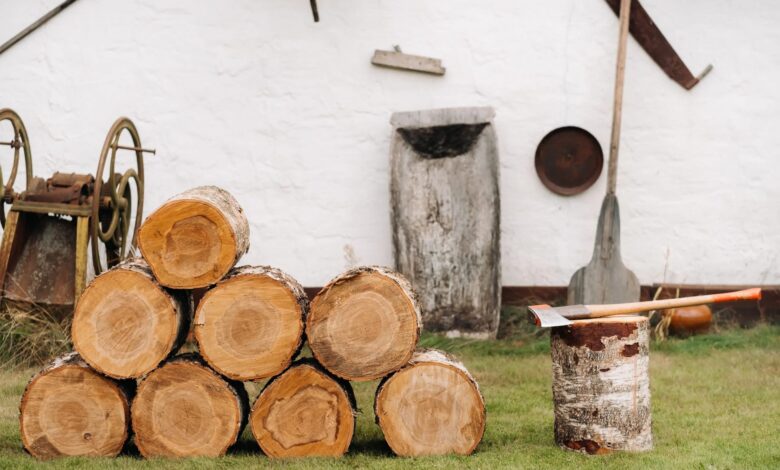A Beginner’s Guide to Firewood: Cutting, Splitting and Storing It Right

Master the basics of firewood prep—from chainsaw safety to splitter use and seasoning techniques—for warmer, cleaner, and safer burns.
Step 1: Cutting Firewood Safely and Efficiently
To enjoy cozy fires in your fireplace or wood burning stove, cutting your own firewood efficiently and safely is crucial. Getting this right helps produce quality firewood that burns cleanly and provides the most heat.
Choose the Right Tools for the Job
Picking the right tools is your first step. Here’s what you’ll need:
- Chainsaw (gas or electric):
Gas chainsaws offer more power for tackling larger logs or a fallen tree, but they’re heavier and louder. Electric models are lighter, quieter, and ideal for smaller tasks. Always check chainsaw features like anti-kickback bars for added safety. - Sawhorse for elevation:
Elevating logs off the ground makes cutting wood safer and more comfortable. It prevents the chainsaw from hitting dirt, extending chain sharpness. - Protective gear:
Don’t skimp here. Always use chaps, sturdy gloves, safety goggles, and hearing protection. Wearing the proper gear drastically reduces injury risks.
I once advised a client who skipped safety gear and nearly lost a toe cutting a fallen tree. Protective equipment isn’t optional—it’s essential.
Best Practices for Cutting Logs
To produce perfect logs for seasoned firewood, follow these expert tips:
- Ideal firewood length (16–18 inches):
Logs of this length fit most wood burning stoves and fireplaces comfortably, providing ample surface area for efficient burning. - Avoid knots and twisted grain:
Cutting around knots saves you headaches later. Knotty logs are tougher when it comes to splitting wood and slow down the drying process. - Cut in late winter or early spring:
This timing means your freshly cut wood will benefit from the warmer summer months, speeding up seasoning into quality, dry firewood.
These steps will help you turn a daunting chore into an enjoyable task. By preparing your own firewood, you control the quality, ensuring efficiently produced, safe-to-burn logs all winter long.
Step 2: Splitting Firewood the Right Way
From axes to hydraulic splitters, here’s how to make splitting firewood safer and easier. The right approach means less effort and safer results when prepping good firewood for your fireplace or stove.
Manual vs. Mechanical Tools
Choosing the right tools depends on your firewood needs:
- Splitting mauls and axes:
A sturdy splitting maul is perfect for dense hardwood like oak or beech. It delivers powerful blows, efficiently breaking apart larger logs.
A lighter splitting axe works well for smaller, easier-to-split pieces of wood, like birch. - Hydraulic log splitters (electric vs. gas):
For larger volumes, hydraulic log splitters save time and effort.
- Electric splitters: Great for homeowners; quiet, simple to operate, ideal for moderate splitting jobs.
- Gas splitters: Handle bigger, tougher logs and are portable but louder and require maintenance.
- Electric splitters: Great for homeowners; quiet, simple to operate, ideal for moderate splitting jobs.
- Wedges and sledgehammers:
Still useful for stubborn or knotty pieces of wood. Set a wedge and drive it with a sledgehammer when other methods fail.
Splitting Techniques for Beginners
Getting started with splitting logs safely involves simple techniques:
- Target cracks in the grain:
Logs usually have natural splits. Aim your axe here for cleaner, easier splits. - Use a stable chopping block:
Always place your wood on a secure, knee-high chopping block. It reduces fatigue and prevents injuries from swinging too low. - Proper stance:
Stand with your feet shoulder-width apart.
Swing your axe downward in a smooth, controlled motion. This gives you power without losing control.
I once helped a neighbor struggling to split tough white oak logs. A slight adjustment to his stance and targeting natural cracks instantly improved his efficiency.
Log Splitter Safety Tips
Operating hydraulic splitters safely is straightforward but crucial:
- Hands away from wedge:
Never place your hands near the wedge while splitting—stay focused and safe. - Use level ground and proper PPE:
Set your splitter on flat ground to avoid tipping. Always wear gloves, goggles, and sturdy boots for protection. - Check for cracks or debris before each split:
Inspect logs for hidden cracks or embedded dirt and stones. This protects you and your splitter from unnecessary damage.
Following these steps will help you produce perfectly split and seasoned firewood efficiently, turning your efforts into warm, enjoyable fires throughout winter.
Step 3: Storing Firewood for Seasoning and Use
Storing your firewood properly preserves your hard work and guarantees a clean, efficient fire. Follow these steps, and you’ll have perfectly seasoned firewood ready when you need it.
How to Stack Firewood Properly
Proper stacking makes all the difference:
- Elevate with pallets or racks:
Never let your wood touch the ground directly. Moisture causes rot and attracts pests, ruining otherwise good firewood. - Leave space between rows for airflow:
Stack your logs loosely, creating gaps for proper air circulation. This speeds up the drying process. - Stack bark-side down in wet climates:
Positioning the bark downward helps water runoff. Your wood dries quicker, reducing the chance of mold or rot.
A client once stacked his fresh-cut oak and beech wood directly on damp soil. By summer’s end, most of it was unusable. Elevating stacks would have saved him both effort and money.
Covering and Location
Protect your firewood without trapping excess moisture:
- Use breathable tarps or roofs:
A simple tarp or lean-to roof shields the top from rain but leaves the sides open. This promotes drying and keeps wood ready to burn. - Store 20+ ft from your home:
Keeping stacks at a safe distance helps prevent pests like termites from invading your house along with the wood. - Avoid trapping excess moisture:
Closed-off or overly covered piles can create mold growth. Store your stacks in a well ventilated area to ensure dry, quality firewood.
How to Tell If Wood Is Ready to Burn
Knowing when your firewood is properly seasoned ensures optimal burning:
- Use a moisture meter (<20%):
Moisture content below 20% guarantees your wood will burn hot and efficiently, perfect for your fireplace or wood burning stove. - Listen for a hollow sound:
Knock two pieces together; dry wood produces a sharp, hollow sound. - Check for darkened, cracked ends:
Properly seasoned wood shows visible cracks and darkened edges, signs it’s ready for the fire.
These simple tips transform your pile of freshly cut firewood into an efficient heat source, giving you comfortable warmth all winter.
Wood Types: What to Burn and Why It Matters
Choosing the right wood is key for efficient wood burning. Different tree species provide unique benefits, so knowing what suits your needs helps ensure a great fire.
Hardwoods vs. Softwoods
Not all firewood is created equal. Here’s how they differ:
- Hardwoods (like oak, hickory, birch, and beech):
- Offer the best heat and longest burn times.
- Perfect for your main fuel source in a fireplace or wood burning stove.
- Oak, especially white oak, is excellent due to its high heat produced and slow-burning nature.
- Offer the best heat and longest burn times.
- Softwoods (like pine and fir):
- Ignite quickly, making them ideal as kindling.
- They have lower density, so they’re easier for splitting logs.
- Be cautious: softwoods produce more creosote, leading to chimney buildup.
- Ignite quickly, making them ideal as kindling.
I once advised a homeowner who exclusively burned pine in his fireplace. After just one season, he needed chimney repairs from creosote damage. Mixing wood types would have prevented this.
Which Wood Is Best for You?
When picking your firewood, consider these points:
- Availability and Budget:
Hardwoods might cost more from local dealers, but provide longer-lasting heat. Softwoods are often cheaper and plentiful. - Burn Needs:
Use softwoods to easily start your fire. Then add hardwoods for sustained warmth, especially during cold months. - Mixing Woods:
A balanced stack—like oak for long burns and pine for starting fires—gives you flexibility and better heat control.
Planning your wood types this way ensures efficient, cost-effective, and enjoyable wood burning all winter long.
When building your winter wood pile, it helps to know which firewood logs burn the longest so you can prioritize heat output and efficiency.
Beginner Mistakes to Avoid
As you start preparing your own firewood, you’ll learn quickly. But dodging these common beginner slip-ups will save you time, effort, and frustration.
Don’t Stack Directly on the Ground
Stacking your firewood directly on the ground is a recipe for trouble:
- Moisture from the soil causes rot, mold, and decay.
- Insects and pests love damp, poorly ventilated piles.
- You’ll end up with unseasoned firewood, even after waiting months.
Instead, use pallets or racks to elevate your stack. This promotes proper air circulation and keeps your wood dry and healthy.
Don’t Wait Too Long to Split
Many beginners delay splitting logs after cutting them. Don’t make this mistake:
- Freshly cut wood is much easier to split than seasoned firewood.
- Once wood dries, it hardens and splitting becomes a chore, especially with larger logs.
- Splitting wood early speeds up the drying process, giving you quality, dry firewood sooner.
I always tell homeowners: plan ahead. Chop and split your logs shortly after cutting to avoid extra work later.
Don’t Burn Unseasoned Wood
Burning fresh wood is tempting, but causes serious issues:
- Unseasoned firewood creates excess smoke and creosote buildup in your chimney.
- The heat produced is much lower, making it inefficient.
- You’ll spend more time cleaning your fireplace or wood burning stove.
Properly seasoned wood means better, safer, and more enjoyable fires. Always check the moisture content before burning, aiming below 20%.
Summary: Your Firewood Success Starts with the Basics
Getting comfortable preparing firewood isn’t hard. Stick to these simple rules, and you’ll master it quickly.
Key Takeaways
- Always use the right tools when cutting wood or splitting logs. A sharp axe, sturdy log splitter, and proper safety gear keep you safe and efficient.
- Never underestimate safety. Protect yourself and others every step—from cutting a fallen tree to stacking your seasoned firewood.
- Proper seasoning and storage ensure your firewood delivers maximum heat with minimal smoke and hassle.
Quick Checklist for Beginners
Use this handy checklist to ensure you’re ready for success:
✅ Chainsaw, gloves, and protective gear
✅ Splitting axe or log splitter
✅ Moisture meter to confirm properly seasoned wood
✅ Elevated wood rack and breathable tarp for proper wood stacking
✅ Basic understanding of wood types like oak, birch, and beech
Follow these tips, and you’ll enjoy warm, clean, and safe fires all season.




